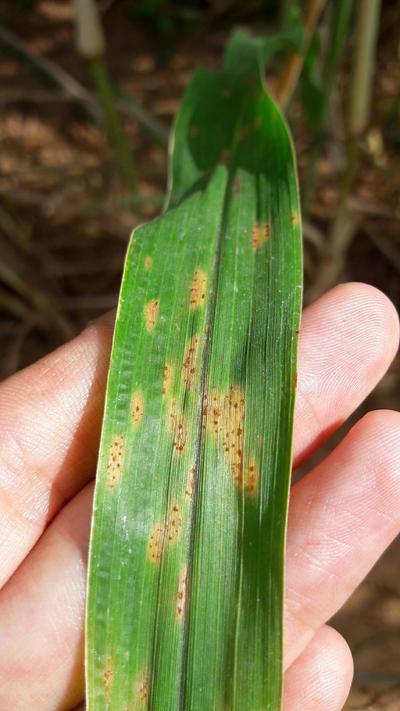Millet Rust
Puccinia substriata
Fungus
In a Nutshell
- Yellow to white spots on leaves.
- Reddish-orange “rusty” pustules with yellow margins during later stages.
Can also be found in
Symptoms
Raised yellow to white spots appear on both sides of the leaf. As the disease progresses, the spots merge and form reddish-orange and rusty pustules. The pustules may have yellow margins and can turn darker at later stages. The leaves may die because of the infection and in severe cases, the plants collapse. The disease can occur at any stage of the crop, but heavy loss will be inflicted if infection occurs before flowering.
Recommendations

Organic Control
Fungal species like Azadirachtin 0.15% or Trichoderma viride 3% can be sprayed to control the rust disease. Alternatively, Aspergillus globosum, Chaetomium globosum, and Trichoderma koningii can be used.

Chemical Control
Always consider an integrated approach with preventive measures together with biological treatments, if available. For smallholders, fungicides are in most cases, not economically feasible. Fungicides like copper compounds, Chlorothalonil, sulphur or Mancozeb can be applied to control rust on millet.
What caused it?
The symptoms are caused by the fungus Puccinia substriata. The pathogen has a wide range of alternative hosts like eggplant and many grass varieties. It can be spread over large distances by wind. Further, the pathogen survives in the soil, on plant residues, and on alternative hosts. Favourable conditions for the fungus are cool nights (15-20°C) and warm days (25-34°C), such that dew can develop on the leaves. This leads to a higher risk of infection.
Preventive Measures
- Use the available resistant varieties for planting.
- Earlier planting can minimize yield and grain quality losses.
- Avoid overhead irrigation.
- Do not plant eggplant or any other solanaceous crops like potato, pepper, and tomato close to millet.
- Control weeds like grasses can be used to manage volunteer plants.
- Ensure good field hygiene.
- Remove any plant residues after harvest and either bury or burn them.
- Rotate millet with sorghum and legumes.



